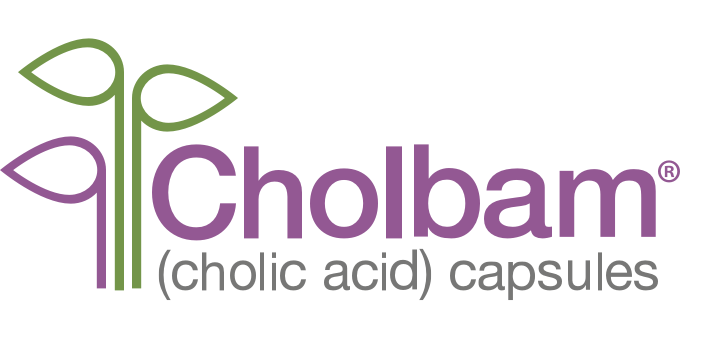
Frequently asked questions
About CHOLBAM
When may CHOLBAM capsules be appropriate?
CHOLBAM® (cholic acid) is a bile acid indicated for:
- Treatment of bile acid synthesis disorders due to single enzyme defects1
- Adjunctive treatment of peroxisomal disorders, including peroxisomal biogenesis disorder-Zellweger spectrum disorder (PBD-ZSD), in patients who exhibit manifestations of liver disease, steatorrhea, or complications from decreased fat-soluble vitamin absorption.1
The safety and effectiveness of CHOLBAM on extrahepatic manifestations of bile acid synthesis disorders due to single enzyme defects or peroxisomal disorders, including PBD-ZSD, have not been established.1
How does CHOLBAM work?
CHOLBAM works by increasing cholic acid levels. By increasing cholic acid in the hepatocyte, CHOLBAM is thought to suppress the production of the hepatotoxic atypical bile acids DHCA and THCA.2
The mechanism of action of cholic acid has not been fully established; however, it is known that cholic acid and its conjugates are endogenous ligands of the nuclear receptor, farnesoid X receptor (FXR). FXR regulates enzymes and transporters that are involved in bile acid synthesis and in the enterohepatic circulation to maintain bile acid homeostasis under normal physiologic conditions.1
Why should I prescribe CHOLBAM?
Treatment with CHOLBAM may help reduce liver injury. CHOLBAM may improve bile flow and increase solubilization of dietary fats and fat-soluble vitamins through emulsification.3,4
The safety and effectiveness of CHOLBAM on extrahepatic manifestations of bile acid synthesis disorders due to single enzyme defects or peroxisomal disorders, including Zellweger spectrum disorders, have not been established.1
How do I dose CHOLBAM?
Starting dose of CHOLBAM for both children and adults should be based on weight. The recommended dose of CHOLBAM is 10 to 15 mg/kg once a day, which can be divided into 2 doses if necessary.1
Please see the CHOLBAM Prescribing Information for dose modification instructions for patients with newly diagnosed, or a family history of familial hypertriglyceridemia, treatment monitoring guidelines, and administration instructions.1
How is CHOLBAM administered?
CHOLBAM should be taken with food. For infants and children who cannot swallow capsules, CHOLBAM capsules can be opened and mixed with either infant formula or breast milk (for younger children), or soft food such as mashed potatoes or apple puree (for older children and adults) in order to mask any unpleasant taste.1
How should I monitor patients taking CHOLBAM?
Monitor AST, ALT, serum GGT, ALP, bilirubin, and INR every month for the first 3 months, every 3 months for the next 9 months, every 6 months during the subsequent 3 years, and annually thereafter. Learn more about monitoring.1
What are potential adverse events with CHOLBAM?
In the CHOLBAM clinical trials, diarrhea was the most common adverse reaction in approximately 2% of the patient population. All other adverse reactions occurred in ≤1% of the patient population.1 See more safety information.
ALT, alanine aminotransferase; AST, aspartate aminotransferase; DHCA, dihydroxycholestanoic acid; GGT, gamma glutamyltransferase; THCA, trihydroxycholestanoic acid.
Testing
What tests are available for BASD patients?
There are 2 tests available at no cost to qualifying patients:
- PreventionGenetics 77-gene cholestasis panel
In partnership with PreventionGenetics, Mirum Pharmaceuticals offers a no-cost testing program for qualifying patients to identify the genetic causes of cholestasis. - Mass spectrometry at Cincinnati Children’s Hospital Medical Center
This urinary bile acid profile test by fast atom bombardment mass spectrometry (FAB-MS) is performed exclusively at Cincinnati Children’s Hospital Medical Center and confirms defects in bile acid synthesis in BASD through the presence of atypical bile acids.
Learn more about these tests.
ALT, alanine aminotransferase; AST, aspartate aminotransferase; GGT, gamma glutamyltransferase.
Bile acid synthesis disorder (BASD)
What is BASD?
BASD due to single enzyme defects involves congenital deficiencies in enzymes required for catalyzing key reactions in the synthesis of the 2 main bile acids—cholic acid (CA) and chenodeoxycholic acid (CDCA).5
Often present in the first few months of life, BASD can produce life-threatening, progressive cholestatic liver disease.6,7
How does BASD present clinically?
BASD, due to single enzyme defects, has distinct clinical features. Symptoms of BASD may include4,8,9:
- Cholestatic jaundice
- Acholic stools
- Hepatomegaly
- Failure to thrive
- Absence of pruritus
Read more about BASD.
How do I establish a clinical diagnosis of BASD?
Lab abnormalities that may be present include3,4,8:
- Elevated bilirubin (mg/dL)
- Elevated ALT/AST (U/L)
- GGT (U/L) ≤150
- Normal to low primary bile acids (serum) (µmol/mL)
If lab abnormalities are present, diagnose with genetic testing or urine bile acid profile.
Learn more about these tests.
ALT, alanine aminotransferase; AST, aspartate aminotransferase; GGT, gamma glutamyltransferase.
Patient Resources
What is the Mirum Access Plus Support Program?
Mirum Access Plus is available to help you, your office, and your patient not only get started with CHOLBAM after you’ve prescribed it, but also to provide support throughout treatment. Learn more about this valuable program.
If you have any questions about Mirum Access Plus, contact us at 1-855-MRM-4YOU (1-855-676-4968) Monday through Friday, 8:00 AM through 8:00 PM ET.
How do I enroll my patients?
If you’d like to prescribe CHOLBAM for your patient, download the Patient Enrollment Form and Patient Authorization Form. Once you have filled out the forms for Mirum Access Plus services, fax them to 1-855-282-4884.
REFERENCES: 1. CHOLBAM. Prescribing information. Mirum Pharmaceuticals, Inc. 2. Braverman NE, Raymond GV, Rizzo WB, et al. Mol Genet Metab. 2016:117(3):313-321. doi: 10.1016/j.ymgme.2015.12.009. 3. Setchell KDR. Defects in bile acid synthesis – specific and treatable causes of metabolic liver disease. Adolf Windaus Prize Lecture. 2004. 4. Rinawi F, Iancu TC, Hartman C, et al. Fat malabsorption due to bile acid synthesis defect. Isr Med Assoc J. 2015;17(3):190-192. 5. Heubi JE, Setchell KDR, Bove KE. Inborn errors of bile acid metabolism. Clin Liver Dis. 2018;22(4):671-687. doi: 10.1016/j.cld.2018.06.006. 6. Bove KE, Heubi JE, Balistreri WF, Setchell KD. Bile acid synthetic defects and liver disease: a comprehensive review. Pediatr Dev Pathol. 2004;7:315-334. doi: 10.1007/s10024-002-1201-8. 7. Clayton PT. Disorders of bile acid synthesis. J Inherit Metab Dis. 2011;34:593-604. doi: 10.1007/s10545-010-9259-3. 8. Sundaram SS, Bove KE, Lovell MA, Sokol RJ. Mechanisms of disease: inborn errors of bile acid synthesis. Nat Clin Pract Gastroenterol Hepatol. 2008;5(8):456-468. doi: 10.1038/ncpgasthep1179. 9. Gonzales E, Gerhardt MF, Fabre M, et al. Oral cholic acid for hereditary defects of primary bile acid synthesis: a safe and effective long-term therapy. Gastroenterology. 2009;137(4):1310-1320. doi: 10.1053/j.gastro.2009.07.043.
INDICATION
CHOLBAM® (cholic acid) is a bile acid indicated for- Treatment of bile acid synthesis disorders due to single enzyme defects.
- Adjunctive treatment of peroxisomal disorders, including Zellweger spectrum disorders, in patients who exhibit manifestations of liver disease, steatorrhea, or complications from decreased fat-soluble vitamin absorption.
LIMITATIONS OF USE
The safety and effectiveness of CHOLBAM on extrahepatic manifestations of bile acid synthesis disorders due to single enzyme defects or peroxisomal disorders, including Zellweger spectrum disorders, have not been established.IMPORTANT SAFETY INFORMATION
WARNINGS AND PRECAUTIONS – Exacerbation of liver impairment
- Monitor liver function and discontinue CHOLBAM in patients who develop worsening of liver function while on treatment.
- Concurrent elevations of serum gamma glutamyltransferase (GGT) and alanine aminotransferase (ALT) may indicate CHOLBAM overdose.
- Discontinue treatment with CHOLBAM at any time if there are clinical or laboratory indicators of worsening liver function or cholestasis.
ADVERSE REACTIONS
- The most common adverse reactions (≥1%) are diarrhea, reflux esophagitis, malaise, jaundice, skin lesion, nausea, abdominal pain, intestinal polyp, urinary tract infection, and peripheral neuropathy.
DRUG INTERACTIONS
- Inhibitors of Bile Acid Transporters: Avoid concomitant use of inhibitors of the bile salt efflux pump (BSEP) such as cyclosporine. Concomitant medications that inhibit canalicular membrane bile acid transporters such as the BSEP may exacerbate accumulation of conjugated bile salts in the liver and result in clinical symptoms. If concomitant use is deemed necessary, monitoring of serum transaminases and bilirubin is recommended.
- Bile Acid Binding Resins: Bile acid binding resins such as cholestyramine, colestipol, or colesevelam adsorb and reduce bile acid absorption and may reduce the efficacy of CHOLBAM. Take CHOLBAM at least 1 hour before or 4 to 6 hours (or at as great an interval as possible) after a bile acid binding resin.
- Aluminum-Based Antacids: Aluminum-based antacids have been shown to adsorb bile acids in vitro and can reduce the bioavailability of CHOLBAM. Take CHOLBAM at least 1 hour before or 4 to 6 hours (or at as great an interval as possible) after an aluminum-based antacid.
PREGNANCY
No studies in pregnant women or animal reproduction studies have been conducted with CHOLBAM.LACTATION
Endogenous cholic acid is present in human milk. Clinical lactation studies have not been conducted to assess the presence of CHOLBAM in human milk, the effects of CHOLBAM on the breastfed infant, or the effects of CHOLBAM on milk production. The developmental and health benefits of breastfeeding should be considered along with the mother’s clinical need for CHOLBAM and any potential adverse effects on the breastfed infant from CHOLBAM or from the underlying maternal condition.GERIATRIC USE
It is not known if elderly patients respond differently from younger patients.HEPATIC IMPAIRMENT
- Discontinue treatment with CHOLBAM if liver function does not improve within 3 months of the start of treatment.
- Discontinue treatment with CHOLBAM at any time if there are clinical or laboratory indicators of worsening liver function or cholestasis. Continue to monitor laboratory parameters of liver function and consider restarting at a lower dose when the parameters return to baseline.

